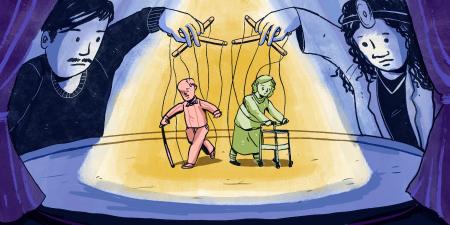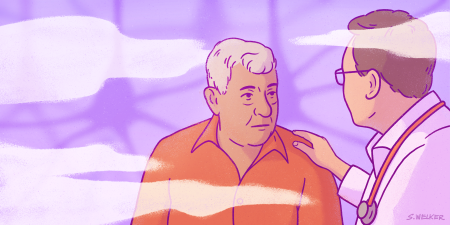Abstract
Ageism is so structurally integrated and normalized in US health care that it is generally unnoticed by clinicians, despite its effects on the medical care and lives of older adults. Clinicians often lack time, incentives, and opportunities to pause and fully consider the perspective of older adults, especially those with mental illness. As a result, clinicians might infantilize older adults and pathologize or dismiss their preferences, values, and capacity for growth. This commentary on a case proposes a narrative-based ethical approach to shift clinicians’ perception of older adults as suffering from the inevitable and unsolvable problems of aging to experiencing a need for dignity and the possibility of continued personal growth.
Case
Mrs P is an 83-year-old widowed woman with ischemic heart disease, hypertension, type 2 diabetes, and generalized anxiety disorder who has been hospitalized for congestive heart failure (CHF) 4 times in the last 2 months. She has not been adherent to her medication regimen and to a low-sodium diet, contributing to CHF exacerbations. Due to uncontrolled anxiety, she has been afraid to leave her apartment to attend primary care appointments. After a recent fall, physical therapy was ordered, but Mrs P did not allow home health staff to enter her home.
Mrs P is now hospitalized for the fifth time. She was restarted on outpatient medications, and her condition improved. She was advised to move into an assisted living facility, an idea that her 2 adult children supported; she refused. Hospice was recommended in order to focus on quality of life; she refused. Due to concerns about her cognition, neurology consultation was requested. Bedside cognitive testing and neurological examination were normal; there was no evidence of delirium or dementia. Due to concerns about capacity to manage her medical problems and live independently, psychiatry consultation was requested. She was found to have decisional capacity for health care; she was very anxious, leading to the antidepressant dose being increased and a referral to a psychotherapist.
As Mrs P approaches discharge, members of her care team express frustration about her high utilization of scarce inpatient resources. They consider requesting ethics consultation about whether further inpatient care of her condition should be discontinued.
Commentary
The population of older adults is increasing each year. In 2019, there were an estimated 703 million people 65 years or older worldwide; this number is expected to double by 2050 to 1.5 billion.1,2 For those working in health care, it is easy to recognize in this case the complicated dynamics involved in health care for older patients.
Ageism, an unfortunately pervasive feature of medicine, is defined as any form of negative attitude, stereotyping, or discrimination against individuals based on their older age.1,3 Like racism and sexism, ageism operates through complex mechanisms at different levels of society, including individual, social, and structural levels.4 In medicine, at the individual level, ageism can manifest as paternalistic and infantilizing approaches to medical decision making, including limiting patients’ involvement despite their intact decision-making capacity and succumbing to the cognitive bias of attributing symptoms simply to old age.5,6,7 At the structural level, ageism can include age-based discriminatory practices, such as exclusion from research or the unjust resource allocation recently observed on a global scale during the COVID pandemic.5,6,7
Ageism results in a significant burden on the health care system, contributing to higher costs and poor health outcomes for older adults. Levy et al estimated the costs of ageism to be $11 billion per year based on analyses of the effects of ageism on—and comprehensive health care spending data on the 1-year costs of—the 8 most-expensive health conditions among older adults in America.8 Conversely, mental illness and subsequent disability can lead to ageist stereotyping, negative attitudes, and discriminatory practices that contribute to poor health outcomes.9 For older adults with mental illness, ageism and stigma constitute a double hit and can compound poor health outcomes. Another product of ageism is that we tend to think of adults as persons who age and of children as persons who grow. This article interrogates this idea in relation to the stories of older adults in our health care system.
Approaches to Understanding and Addressing Ageism
Behavioral scientists have developed a series of approaches to understanding ageism, including the stereotype embodiment theory, which proposes that stereotypes are embodied when their assimilation from the surrounding culture leads to self-definitions that in turn influence functioning and health.10 Others have taken a human rights-based approach, examining the role of dignity in health care and its impact on ageism and the human rights of older persons.11 A deontological approach prioritizes rules that individuals and societies should follow based on common values and agreed-upon social contracts12; on human rights-based and deontological approaches, ageist practices would be seen as unacceptable violations of autonomy or agency. On the other hand, a consequentialist approach, which may be invoked to justify rationing of health care resources based on age,13 could promote ageist practices. Virtue ethics takes an entirely different tack, placing the experience of the people at the forefront of ethical decision making.14 For example, by empowering older adults to make decisions about their health care even in the context of scarcity, clinicians will foster their own virtues by respecting the autonomy of persons of all ages.13
Here, we would like to consider narrative-based ethics as a way of understanding and addressing ageism, with a focus on incorporating older adults’ capacity for growth as a means of countering ageism in health care. Narrative medicine refers to an approach first proposed by Rita Charon.15 Charon, a professor of medicine who holds a doctorate in English literature, describes key elements or goals of the narrative approach: to use listening skills and the centrality of story to develop an understanding of patients’ lives, to better understand patients’ individual experiences of illness and their concerns, to strengthen the bond between physicians and patients, and to appreciate the common and important phenomena of guilt and shame in the experience of illness.16
How patients organize their stories yields information beyond content alone.
The narrative medicine approach is built upon an appreciation of the medical humanities. Medical humanities is a relatively young field that considers the overlap between the humanities—the arts, literature, poetry, film, music, dance, and more—and medical concerns. We can, for example, apply the same principles involved in analyzing a story, novel, poem, film, or piece of art in describing our patients and their attendant clinical or ethical problems. Doing so can help us preserve a sense of ambiguity when approaching problems that demand careful consideration rather than premature decision making.
The medical humanities provide ample material for clinicians and trainees to explore the experience of aging. Reading, as well as viewing film and art, can build empathy and understanding of aging. The goal of considering and discussing such works is to enable us, as physicians, to use our moral imaginations to vicariously experience the phenomenon of aging in order to better understand our patients. For example, former US poet laureate Billy Collins mourns the loss of memory in his poem, “Forgetfulness.”
No wonder you rise in the middle of the night
to look up the date of a famous battle in a book on war.
No wonder the moon in the window seems to have drifted
out of a love poem that you used to know by heart.17
In the movie The Father, Anthony Hopkins depicts a man who does not realize he is developing dementia, much less the impact of his illness on his family. Two nonfiction works are especially relevant for understanding the experience of aging: Elderhood by Louise Aronson and Being Mortal by Atul Gawande.18,19 Each of these books, written by a physician, explores aging, death, and dying in the context of the patient-physician relationship, with an emphasis on the narratives and values of patients as their doctors help them adapt to illnesses.
A Narrative Approach to Ageism
What does the narrative approach look like in clinical practice? Narrative medicine has various practical implications for clinicians interacting with their patients. These include a focus on the narrative arc of patients’ understanding of their own lives.20,21 Rather than asking, “What brings you to the clinic/hospital?,” a clinician committed to the narrative approach might begin an interview with: “Before we explore your medical problems, could you tell me about yourself for 10 minutes?” Physicians and patients benefit from this approach, as even a brief exploration of patients’ developmental history and their individual narrative often helps physicians more firmly ground their premorbid identities and may serve to help their “cases” stand out.
How patients organize their stories may yield information beyond content alone. For example, providing a history with few details may suggest that the person is cautious about what they disclose to others or is mistrustful of health care professionals. Multiple or perhaps even repetitive questions might suggest worry about one’s condition that a clinician should address. A patient with extensive or elaborate responses might be lonely or bored and appreciate the opportunity to talk to someone.
Returning to our case, we wonder what we might have learned had we asked Mrs P about her developmental history. For example, her parents may have instilled in her a strong respect for older adults and the expectation that children care for their parents. An expectation that her children will be more involved in her care may have contributed to her rejecting the recommendation to move to an assisted living facility.
The vignette notes that Mrs P is widowed. It may be helpful to explore what her relationship was like with her spouse, what the circumstances of her spouse’s death were, and to what extent she may still be grieving. For example, if Mrs P was her spouse’s caregiver, then this role may be influencing her views of illness and the health care system. If her spouse required assisted living or skilled nursing care, this circumstance may color her perception of herself moving into such a setting.
We also wonder about the nature of the interactions between Mrs P and her health care team. Consulting multiple specialists may have conveyed to Mrs P, who is cognitively intact, that they doubt her ability to care for herself and make her own decisions.
Finally, we can’t tell from the vignette what matters most to Mrs P. “Matters Most to Me” is 1 of the “5 M’s” of geriatrics, which also include mind, mobility, medications, and multicomplexity, all of which are relevant in this case.22 The What Matters Most-Structured Tool asks people to rate how important various values and goals are—the ability to take care of oneself, to have physical or sexual intimacy, to have relationships with family and friends, to avoid being a burden to others, to have privacy, and so on.23 It would also be important to assess the influence of religious or spiritual beliefs on Mrs P’s decision making and how much input she wants from family and from her doctors about her health care decisions.
It’s clear that the case is missing many salient features of Mrs P’s story, including what she hopes she will do in the next chapter of her life. Narrative approaches would have helped elicit her unique life course and experiences while highlighting her values and preferences.
Conclusion
The narrative approach can strengthen our appreciation of older adults’ personhood and their continued capacity for growth by helping us center each patient’s values as rooted in their lived experience. The humanities help us both to interrogate the values, attitudes, and stories that we, as clinicians, bring to our interactions with older adults and to challenge our preconceptions of aging as only a time of decline and loss.
References
- Banerjee D, Rabheru K, de Mendonca Lima CA, Ivbijaro G. Role of dignity in mental healthcare: impact on ageism and human rights of older persons. Am J Geriatr Psychiatry. 2021;29(10):1000-1008.
-
Department of Economic and Social Affairs. World population ageing 2019: highlights. United Nations; 2019. Accessed November 1, 2022. https://www.un.org/en/development/desa/population/publications/pdf/ageing/WorldPopulationAgeing2019-Highlights.pdf
-
Wilkinson JA, Ferraro KF. Thirty years of ageism research. In: Nelson TD, ed. Ageism: Stereotyping and Prejudice Against Older Persons. MIT Press; 2002:339-358.
-
Marques S, Mariano J, Mendonça J, et al. Determinants of ageism against older adults: a systematic review. Int J Environ Res Public Health. 2020;17(7):2560.
- Nemiroff L. We can do better: addressing ageism against older adults in healthcare. Healthc Manage Forum. 2022;35(2):118-122.
- Dobrowolska B, Jędrzejkiewicz B, Pilewska-Kozak A, et al. Age discrimination in healthcare institutions perceived by seniors and students. Nurs Ethics. 2019;26(2):443-459.
-
Wyman MF, Shiovitz-Ezra S, Bengel J. Ageism in the health care system: providers, patients, and systems. In: Ayalon L, Tesch-Römer C, eds. Contemporary Perspectives on Ageism. Springer; 2018:193-212. Powell JN, Chen S, eds. International Perspectives on Aging; vol 19.
- Levy BR, Slade MD, Chang ES, Kannoth S, Wang SY. Ageism amplifies cost and prevalence of health conditions. Gerontologist. 2020;60(1):174-181.
-
Mental health of older adults. World Health Organization. December 12, 2017. Accessed November 21, 2022. https://www.who.int/news-room/fact-sheets/detail/mental-health-of-older-adults
- Levy B. Stereotype embodiment: a psychosocial approach to aging. Curr Dir Psychol Sci. 2009;18(6):332-336.
-
Cairns D, Williams V, Victor C, et al. The meaning and importance of dignified care: findings from a survey of health and social care professionals. BMC Geriatr. 2013;13:28.
-
Alexander L, Moore M. Deontological ethics. In: Zalta EN, ed. Stanford Encyclopedia of Philosophy. November 21, 2007. Updated October 30, 2020. Accessed June 27, 2023. https://plato.stanford.edu/entries/ethics-deontological/
- Jecker NS, Pearlman RA. Ethical constraints on rationing medical care by age. J Am Geriatr Soc. 1989;37(11):1067-1075.
-
Hursthouse R. Virtue ethics. In: Zalta EN, ed. Stanford Encyclopedia of Philosophy. July 18, 2003. Updated October 11, 2022. Accessed June 27, 2023. https://plato.stanford.edu/entries/ethics-virtue/
- Charon R. Narrative medicine: attention, representation, affiliation. Narrative. 2005;13(3):261-270.
- Charon R. To see the suffering. Acad Med. 2017;92(12):1668-1670.
-
Collins B. Forgetfulness. In: Questions About Angels: Poems. University of Pittsburgh Press; 1999:20.
-
Aronson L. Elderhood: Redefining Aging, Transforming Medicine, Reimagining Life. Bloomsbury Publishing; 2019.
-
Gawande A. Being Mortal: Medicine and What Matters in the End. Metropolitan Books; 2014.
-
Murphy JW, Franz BA. Ethics in narrative health interventions. Perm J. 2019;24:19.029.
-
Roest B, Milota M, Leget C. Developing new ways to listen: the value of narrative approaches in empirical (bio)ethics. BMC Med Ethics. 2021;22:124.
-
Tinetti M, Huang A, Molnar F. The geriatrics 5m’s: a new way of communicating what we do. J Am Geriatr Soc. 2017;65(9):2115.
- Moye J, Driver JA, Owsiany MT, et al. Assessing what matters most in older adults with multicomplexity. Gerontologist. 2022;62(4):e224-e234.



